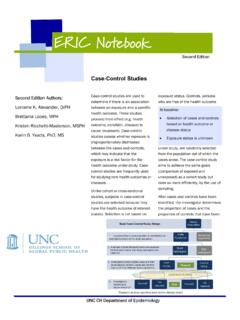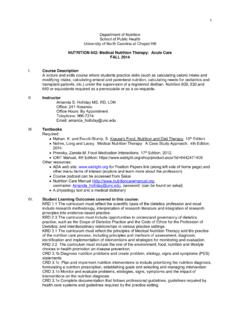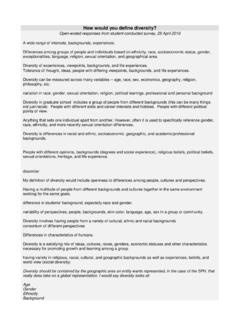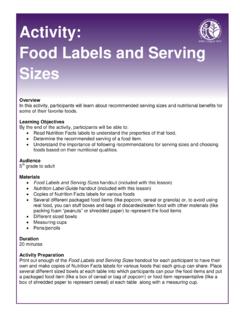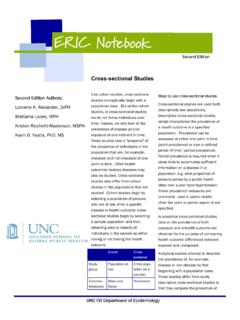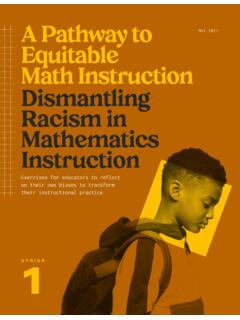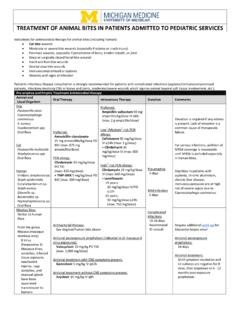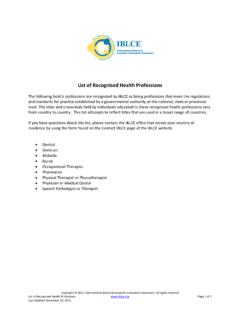Transcription of Confounding Bias, Part II and Effect Measure Modification
1 ERIC at the UNC CH Department of Epidemiology Medical Center Confounding Bias, Part II and Effect Measure Modification E R I C N O T E B O O K S E R I E S Confounding is one type of systematic error that can occur in epidemiologic studies, and is a distortion of the association between an exposure and health outcome by an extraneous, third variable Effect Measure Modification (EMM) is when a Measure of association, such as a risk ratio, changes over values of some other variable. In contrast to Confounding which is a distortion, EMM is of scientific interest ,answers a research question, and can help identify susceptible or vulnerable populations.
2 Are children with poor nutrition, exposed to water pollution, at higher risk of gastrointestinal symptoms compared with children with good nutrition who are exposed to water pollution? Both Confounding and EMM can be considered in the design phase of research or in the analysis phase. We will discuss both in this notebook. Calculating and adjusting for Confounding The previous issue of ERIC Notebook, Confounding Bias, Part I , discussed two criteria for identifying potential confounders in a study. Once potential confounders have been identified, the next step is to evaluate if and how much the confounders bias the study results.
3 To do this, results where Confounding is ignored, the "crude" Measure of association, are compared to results that have been corrected for distortions due to Confounding , the "adjusted" Measure of association. Methods to calculate adjusted measures of associations differ by the need to control each confounder individually or all confounders simultaneously. Second Edition Authors: Lorraine K. Alexander, DrPH Brettania Lopes, MPH Kristen Ricchetti-Masterson, MSPH Karin B. Yeatts, PhD, MS Second Edition This methodology makes 2 assumptions: First, the data are obtained by simple random sampling rather than by some more restrictive subject selection procedure, like matching.
4 The second assumption is that the exposure, health outcome, and confounder variables are all dichotomous ( , having only two strata). If the variables are in a continuous format, they can either be dichotomized, or they must be adjusted for simultaneously to calculate the true Measure of association. ERIC at the UNC CH Department of Epidemiology Medical Center Before calculating an adjusted Measure of association using stratified analyses, one must first assess the presence of Effect Measure Modification (EMM).
5 When Effect Measure Modification is present, it can be difficult to ascertain whether or not Confounding is occurring. What is Effect Measure Modification ? When estimates of an exposure-health outcome relationship stratified by a confounder are sufficiently different from one another ( , risk ratio level 1= and risk ratio level 2 = ), they suggest that two different exposure-health outcome relationships may be operating, one in each level of the confounder. EMM is different from Confounding , where instead of "competing" with the exposure of interest in explaining the etiology of a health outcome or disease, the Effect Measure modifier identifies subpopulations that are particularly susceptible to the exposure of interest.
6 Is Effect Measure Modification present? To calculate whether EMM may be occurring in the study, first calculate three measures of association: A = The overall, crude Measure of association of the exposure-health outcome B1 = The Measure of the exposure-health outcome association among all study participants who have a history of the Confounding variable (C+) B2 = The Measure of the exposure-health outcome association among all study participants who do not have a history of the Confounding variable (C-) Use the Figure 1 below as a guide on how to interpret the meaning of these three measures of associations.
7 As a general rule, if B1 and B2 are basically equal in value, but different from A, then Confounding is present and EMM is not present. EMM is present when B1 and B2 are different from one another, and at least one (B1 or B2) is different from A. Both EMM and Confounding can occur simultaneously. If stratified analysis is used to adjust for EMM, confounders should be addressed using more complex statistical techniques, as stratifying results on more than E R I C N O T E B O O K PA G E 2 Two examples of EMM are: A breast cancer education program (the exposure) that is much more effective in reducing breast cancer in rural areas than urban areas.
8 Here, the area (rural or urban) is an Effect Measure modifier. The finding that a reduction in regional public transportation services (the exposure) affects individuals with little or no access to a car much more than those individuals with access to a car. In this example, having access to a car is the Effect Measure modifier. Figure 1 Risk Ra-tio Exam-ple If the crude Risk Ratio is here ERIC at the UNC CH Department of Epidemiology Medical Center one variable splits the sample into significantly smaller sample sizes and limits generalizability.
9 Calculating adjusted summary estimates If no EMM is present, then stratum-specific estimated effects can be pooled to form a summary estimate of Effect across strata. This summary estimate represents an adjusted risk ratio (a risk ratio adjusted for Confounding ). Although there are many ways to calculate the adjusted risk ratio, the Mantel Haenszel procedure, is the most common pooling procedure. Calculating adjusted measures when all confounders are assessed simultaneously Simultaneous control of two or more variables can give different (and potentially more interesting) results from those obtained by controlling for each variable separately.
10 Simultaneous control of confounders better emulates the natural environment where exposures, diseases, and confounders of interest are found, than does individual control of confounders. Simultaneous control of several confounders to calculate adjusted measures is done through mathematical modeling. To control for Confounding using mathematical modeling, simply include the Confounding variables as independent variables in the model. The simplicity of this method of adjustment for Confounding is one of the attractive features of using mathematical models in epidemiology.

